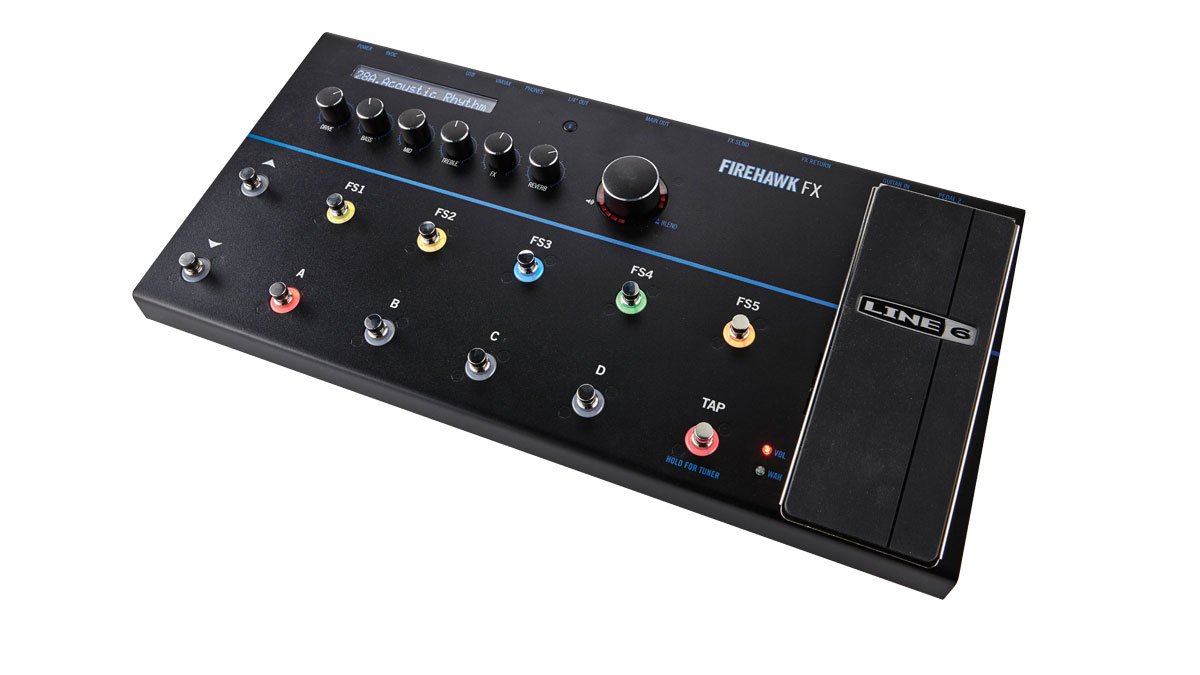MusicRadar Verdict
The Firehawk FX offers plenty of bang for your buck for home practice, recording and - given its rock-solid build quality - gigging, too.
Pros
- +
Excellent value for money. Extremely flexible - lots of connection options. Unlimited presets.
Cons
- -
Time lag when changing presets.
MusicRadar's got your back
With its AMPLIFi line, Line 6 moved the emphasis away from direct hands-on control of its hardware to wireless app tweakability on a smartphone or tablet.
The latest Bluetooth-enabled device is the Firehawk FX, a large floor pedal not entirely dissimilar in size and layout to the company's successful POD HD500X. Some of the Firehawk FX's digitally modelled sounds are HD models, also familiar to users of the POD HD series, while the rest are taken from the POD Farm software.
In all, you get a choice of 108 amps, 120 effects and 24 cabinets to use in your presets, each of which is put together using a series of blocks.
"Editing and creating presets is extremely straightforward when using the app"
There are blocks for amplifer/cabinet, gate, volume, wah, stomp (distortion and more), compressor, EQ, modulation, delay and reverb - you can also have a block for the real-world stompboxes and pedals that you can connect into the external effects loop, and there's also a looper that's activated by a single footswitch.
You can set the order of the blocks in a number of ways, but there isn't as much flexibility as you get in the HD500X with its dual signal path.
Editing and creating presets is extremely straightforward when using the app - we used an iPad, but Android devices are also supported by the Firehawk FX. A preset's signal path is clearly laid out, as are the parameters for any selected block for easy fingertip adjustment.
The Bluetooth connection brings with it other advantages, too - you can stream music to your Firehawk and mix it in proportion to your guitar sound if you want to play along, while you also get access to the web-based Tone Cloud, where you'll find a huge number of user-posted tones that you can use and maybe add to - you can also save and recall an unlimited number of presets besides the 128 onboard the Firehawk FX.
"It's really a swings and roundabouts thing between this and the HD500X, depending on how you intend to use it"
There are loads of different connection possibilities, whether you are using the Firehawk FX with an amp, straight into a PA, with headphones or via USB to record straight to a computer, although there's only an input for guitar, so you can forget about recording with a microphone.
Variax guitar users get some practical integration via a Variax connection. In use, the two rows of footswitches are easily operated for changing preset banks, calling up the four presets in each and switching effects in and out within a preset.
There is, though, a small time lag when changing presets, so the practical way to use the Firehawk FX on stage might be to stick with one preset for the song and bring the effects in and out.
It's really a swings and roundabouts thing between this and the HD500X, depending on how you intend to use it. But, with a range of sounds to cover most playing styles, the Firehawk FX offers plenty of bang for your buck for home practice, recording and - given its rock-solid build quality - gigging, too.
Trevor Curwen has played guitar for several decades – he's also mimed it on the UK's Top of the Pops. Much of his working life, though, has been spent behind the mixing desk, during which time he has built up a solid collection of the guitars, amps and pedals needed to cover just about any studio session. He writes pedal reviews for Guitarist and has contributed to Total Guitar, MusicRadar and Future Music among others.
““We were arguing a lot and we were miserable”: How Green Day exceeded expectations with their most ambitious song
"There’s plenty for us guitarists to learn – and ‘less is more’ is the overriding lesson": how to play like George Harrison on The Beatles' Abbey Road
“They didn’t like Prince’s bikini underwear”: Prince’s support sets for the The Rolling Stones in 1981 are remembered as disastrous, but guitarist Dez Dickerson says that the the crowd reaction wasn’t as bad as people think











